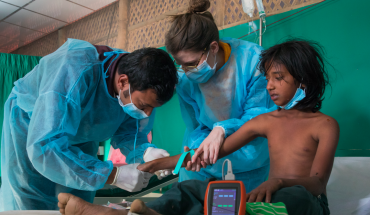Novel map reveals how immune cells fight and remember infections: Researchers have charted the activity of tens of thousands of genes in mouse immune cells over the course of an infection to create the first full dynamic map of how cells learn to fight microbes, and then preserve a memory of this for future infections.
The findings, published in the journal Nature Immunology, could help scientists develop new vaccines and therapeutics for a range of diseases by guiding their research into a particular set of immune cells, known as CD4+ T cells, that are essential for generating immunity.
The international research team was led by University of Melbourne’s Dr. Ashraful Haque, a Laboratory Head at the Doherty Institute, and Dr. Sarah Teichmann, Head of Cellular Genetics at the Wellcome Sanger Institute, Hinxton, UK. They studied the CD4+ T cells during an experimental infection of mice with malaria-causing parasites, which invade and multiply inside red blood cells. With the aid of machine learning techniques, the research team combined the gene activity data over four weeks of infection to generate a comprehensive map of the developmental journeys taken by CD4+ T cells.
“We traced thousands of individual genes to generate a map from initial infection to periods when cells firstly ‘decide’ between various immune roles for fighting the infection, and secondly preserve memories of that encounter.” Dr. Haque said.
“Our map revealed several novel genes that were active – in particular, in a type of CD4+ T cells called T follicular helper cells. These are essential for making antibodies that protect against malaria but have not yet been well studied,” he said.
“Importantly, while our map was generated using an experimental model of malaria, it will be useful for studying T cell responses in almost any infectious or non-infectious disease, or treatment in which T cells are involved”, added Dr. Teichmann.
The scientists have shared their data through a freely available digital resource, allowing any researcher to track the response of individual genes after infection.
“Further investigations are needed to confirm that human cells have a similar map to mouse CD4+ T cells. However, we hope this discovery can point researchers in the right direction towards developing new vaccines for infectious diseases, new immune-therapies for certain cancers, and novel ways to prevent auto-immune conditions.” Dr Teichmann said.
The map is freely available to immunology researchers worldwide. More information can be found on the Haque Lab website.

An artistic representation of the cells’ developmental journeys. Artwork credit: Dr. Philippa M. Saunders, Doherty Institute and University of Melbourne.
- Gut microbiome could delay onset of type 1 diabetes - 3rd April 2025
- The da Vinci 5 Robot Is Set To Transform Bariatric Care: - 31st March 2025
- Beyond money: the hidden drivers fuelling child food insecurity - 31st March 2025






